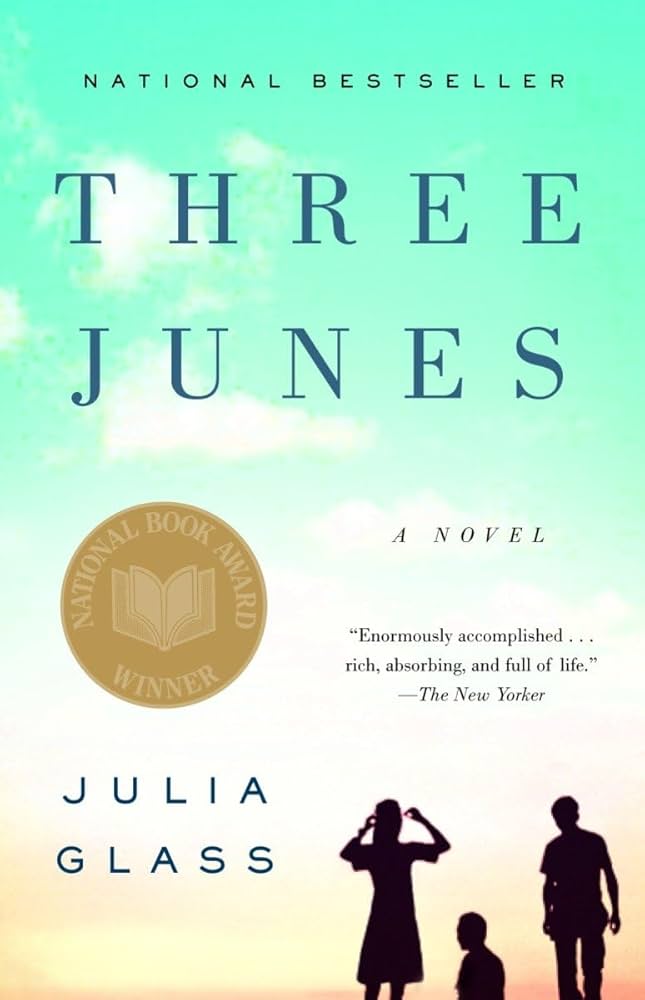Spoilers:
- Fenno’s father dies unexpectedly.
- Fenno is secretly in love with Tony.
- Mal’s marriage is failing.
- Fern reconnects with her past lover Paul.
- Lillian has a secret affair.
- The trip to Greece changes Fenno.
- Paul cares deeply for Fern, even years later.
- Lillian struggles with widowhood.
- The Junes tie all characters’ lives together.
Three Junes: Basic Statistics
| Aspect | Details |
|---|---|
| Title | Three Junes |
| Author | Julia Glass |
| Genre | Literary Fiction |
| Publication Date | 2002 |
| Publisher | Pantheon Books |
| Pages | 353 |
| Awards | National Book Award for Fiction |
| Setting | Scotland, Greece, United States |
| Main Themes | Family, Love, Grief |
“Three Junes” by Julia Glass is an intricately woven tapestry of humanity — a deeply emotive, insightful exploration of relationships, identity, love, and the abiding influence of serendipity over our lives. The three-tiered narrative unfolds with captivating emotional intensity and exquisite literary dexterity, reflecting Glass’s astute perspectives on life, love, and loss. At the nucleus of this novel lie diverse yet interconnected relationships caressed by time, tied together by the common thread of Agnostic Scottish newspaper publisher, Paul McLeod. The temporally divergent narratives give us an unprecedented view of Paul’s life and his family, as Glass demonstrates masterful control over narrative perspective. Her intimate character-study serves as a cathartic journey, pursuing deeply ingrained human frailties, desires, and anxieties.”Three Junes” is a quietly provocative study of cold loss confronting warm hope, of silent suffering fostering resilient love. Its profundity lies in the fact that it doesn’t shy away from showcasing not just highlights but also the incompleteness, confusion, and resentments in human lives — making it all the more identifiable and authentic. Glass’s keen exploration of the dynamics of human relationships and their impact over time is enriched further by her nuanced understanding of mortality’s omnipresent shadow, unearthing the bittersweet essence of life itself.The brilliance of “Three Junes” lies in its emotional resonance, intellectual depth, and unwavering subtlety, demonstrating that life’s most profound moments evolve from simplicity. Glass’s perceptive literary canvas, capturing the undulating landscape of human consciousness with its joy, solitude, and despair, implores readers to reflect upon their lives. Her refined storytelling and lyrical prose rekindle our faith in love, family, and our shared humanity, making “Three Junes” a remarkably compelling narrative. It provokes introspection and ignites understanding, making us lifelong students of the human heart and its fleeting seasons. Overall, “Three Junes” is an emotion-stoked testament to Glass’s rich literary prowess, a deeply insightful portrayal of life’s inherent intricacies and inevitable beauty. It is undeniably a gift of self-reflection — a novel to cherish, ponder, and remember.
Introduction to “Three Junes”
“Three Junes” is a novel by Julia Glass, first published in 2002. It secured the National Book Award for Fiction that same year. The narrative is a compelling exploration of family dynamics, loss, love, and self-discovery. Set across three different Junes, spanning ten years and taking place in Greece, Scotland, and New York, the novel intricately weaves together the lives of the McLeod family.
Interesting Facts and Speculation
- The novel is Julia Glass’s debut work, marking a powerful entry into literary fiction.
- “Three Junes” has often been compared to Virginia Woolf’s works due to its stream-of-consciousness style and rich character introspection.
- Julia Glass has stated in interviews that the idea for the book stemmed from a eulogy she attended, sparking the concept of exploring the lives of interconnected strangers.
- There’s speculation that the character Fenno McLeod has autobiographical elements, reflecting Julia Glass’s own experiences with family and identity.
- An interesting twist noticed by readers is the non-linear narrative, which challenges readers but rewards them with a deeper understanding on re-reading.
Public Perception Over Time
Upon release, “Three Junes” received critical acclaim for its lyrical prose and complex storytelling. Despite being a debut novel, it resonated with a broad audience. Winning the National Book Award solidified its status as a notable literary work.
Over the years, the public’s perception of “Three Junes” remains largely positive. It’s considered a thought-provoking read that beautifully captures the intricacies of human relationships. However, some readers find the narrative structure challenging due to its time-jumping and shifting perspectives.
While “Three Junes” doesn’t have the enduring pop culture impact of some contemporaries, it retains a loyal readership. It’s frequently recommended by book clubs and continues to be appreciated for its intimate portrayal of life and relationships.
Bizarre or Interesting Elements
Although not bizarre in the conventional sense, the novel’s approach to narrative form stands out. It intertwines three separate yet connected stories, much like a triptych in art. This structure requires readers to piece together different timelines and perspectives, offering fresh insights with each revisit.
Three Junes: A Snappy Beat-by-Beat Breakdown
Beat 1: Paul’s Grecian Adventure
- Paul McLeod, a Scottish publisher, jets off to Greece post-widowhood. Greek sun, existential musings, encounters that twinge the heart.
- Meetings with locals and tourists alike stir Paul’s reflections on his late wife and their shared life. Introspection with a side of Mediterranean charm.
Beat 2: Fenno’s Manhattan Days
- Jump to Fenno, Paul’s gay son, living the New York life—intellectual, reserved, a bit of a loner. Bookstores, bird-watching, and boundary-setting.
- Encounters with a flamboyant neighbor and the illness of a close friend bring emotional depth. Deep dives into love, loss, and what it means to truly live.
Beat 3: Fern’s Story Unfolds
- Fern, an unexpected link between the first two narratives, grapples with her own life’s complications in Scotland. A pregnancy, new beginnings, and connections that come full circle.
- Her narrative weaves the previous stories tighter, offering closure and new paths. Grief, growth, and the generational echo of choices.
Endgame: The Convergence
- By the third June, the characters’ lives intersect and intertwine in ways that underscore the novel’s core themes. Family, identity, and the indelible marks of the past.
- The emotional punch of realization and reconciliation. Three Junes, three stories, one unforgettable narrative weave.

Opening of Three Junes
The opening of “Three Junes” by Julia Glass sets an intriguing tone. It introduces the reader to familiar yet complex emotional landscapes. The prose is straightforward but layered, engaging immediately with themes of love, loss, and connection. The author utilizes an omniscient narrative style that allows for insights into multiple characters at once, giving the reader a broad perspective from the start. The first chapter includes elements of time, nature, and place, skillfully balancing these to ground the emotional arcs.
Story Formula Breakdown
“Three Junes” follows a loose structure that can be broken down as follows:
- Set Up: The story begins in a specific time frame and place, focusing on the life of Paul McLeod in the Scottish Highlands.
- Inciting Incident: The death of Paul’s partner brings an unavoidable shift in the lives of the characters, propelling them into reflection and reevaluation.
- Rising Action: The three parts of the book explore the lives of Paul, his family, and their intertwined relationships over the course of several years.
- Climax: As revelations unfold, emotional peaks are reached; misunderstandings and hidden truths surface, altering relationships profoundly.
- Falling Action: The characters begin to come to terms with their revelations, addressing their past and looking toward the future.
- Resolution: The conclusion provides a sense of closure while lingering questions remain, reflecting the complexity of life and relationships.
Character vs. Story-Driven
The story is more character-driven. Characters evolve through their experiences, relationships, and inner conflicts. The narrative digs deep into their psyche rather than relying heavily on action or plot twists. The emotional journeys of the characters take center stage, making every decision and interaction pivotal.
Memorable Characters
What makes characters like Paul McLeod, Fern, and the others memorable is their complexity and relatability. They experience real-world struggles with love, grief, and self-discovery. Each character has flaws, strengths, and unique perspectives that resonate with readers. Their interactions feel genuine, and their development throughout the narrative is engaging.
Main Characters
- Paul McLeod: A middle-aged man grappling with the loss of his partner. He is introspective and often retreats into his memories, reflecting on love and grief.
- Fern: Paul’s close friend, dealing with her own personal struggles. She serves as a contrast to Paul, highlighting themes of independence and vulnerability.
- Malcolm: Paul’s son, navigating his relationship with the family while grappling with his identity and past.
- Various secondary characters: These individuals enrich the narrative by representing different aspects of life and relationships, adding depth to the primary characters’ journeys.
Story Flow Template
When writing a character-driven story similar to “Three Junes,” consider the following template for structure:
- Introduce your main character: Establish their current life situation and emotional state.
- Present an inciting incident: Introduce a significant event that challenges the character’s status quo.
- Develop secondary characters: Introduce friends, family, or acquaintances that will play a role in the story.
- Explore relationships: Delve into the dynamics between characters, highlighting conflicts and connections.
- Build tension: Create emotional peaks where characters must confront their inner demons and confront each other.
- Reveal truths: Allow for misunderstandings to surface, leading to confrontations and resolutions.
- Conclude with reflection: Provide closure without tying up every loose end, allowing for ambiguity in character futures.
Simple Story Description
In essence, “Three Junes” is about the intricate dance of love, loss, and family ties. The narrative unfolds across three summers, highlighting moments of joy and grief as the main characters navigate their complicated lives. It’s a poignant exploration of how time and relationships shape us, pushing us to grow and face our realities.
Inciting Incident in “Three Junes”
The inciting incident occurs when Paul McLeod attends the funeral of his father. This event sets off a chain reaction that triggers the exploration of family, grief, and identity.
Symbolism lies in the funeral itself. It’s not just about death; it represents the beginning of Paul’s journey into understanding his family’s dynamics and his own past. The loss prompts reflection and reveals hidden layers within each character.
Act Structure Detailed
The book is divided into three distinct sections, each focusing on different characters over the course of three Juness. Each act has a rising action, climax, and resolution.
- First Act: Primarily features Paul. After his father’s death, we delve into his memories and family conflicts. Tension builds around unresolved issues of sexuality and family expectations.
- Second Act: Shifts focus to Fern, Paul’s mother, and her attempts to manage her grief. The act explores her relationship with Paul and introduces external pressures, creating further tension.
- Third Act: Centers on the character of Tony and his perspective. This act provides the culmination of revelations and connections between characters, handling themes of love and acceptance.
Climax of the Story
The climax occurs when Paul confronts his feelings about his father and ultimately embraces his identity. The emotional capital here is immense; it’s a moment of acceptance that resonates with broader themes of understanding oneself and one’s heritage.
The build-up involves layers of family interactions and personal struggle. Each character’s arc culminates in this moment, where the past collides with the present, emphasizing the weight of family legacies.
Tension and Release
The book builds tension through complex relationships and unresolved conflicts, particularly surrounding sexuality and familial expectations. Each act presents new layers, keeping the reader engaged.
Release occurs through moments of introspection, connection, and resolution. Paul’s journey toward acceptance of his past provides relief and a sense of closure for both him and the reader.

Understanding the Ending of Three Junes
The ending of “Three Junes” brings together the various threads of the characters’ lives after a series of significant events. Paul, the main character, reflects on his past, particularly his relationships with his family and the impact of loss on his life. He finds a sense of closure and acceptance as he moves toward building a new beginning.
How Writers Categorize the Ending
The ending might be categorized as resolution. It wraps up the character arcs and provides a sense of peace, contrasting earlier turmoil.
Symbolic, Thematic, and Speculative Meanings
- Symbolic: The natural surroundings symbolize growth and healing.
- Thematic: Themes of love, loss, and the importance of family emerge strongly.
- Speculative: It hints at future possibilities. Characters are poised for new relationships and life changes.
Loose Ends and Payoffs Resolved
Character relationships are clarified, particularly Paul’s understanding of his father and his own identity. The ending resolves questions about family ties and personal growth.
Character Changes by the End
Paul grows from a man burdened by responsibilities and grief into someone who embraces life again. Other characters also find clarity in their emotions and futures, indicating significant growth.
Lessons for Writers
Writers can learn the importance of wrapping up character arcs in a satisfying way. Show gradual change in characters and allow space for reflection. Endings don’t need to be dramatic; they can be subtle yet impactful.
Dialogue Style in “Three Junes”
The dialogue in “Three Junes” is direct and often intimate. It captures the nuances of relationships and the quiet moments that define them. Characters communicate openly, revealing their thoughts and emotions in a straightforward manner.
Examples of Dialogue
One example is a conversation between Paul and his father:
“I wish you’d just let me in, just for a moment,” Paul says, his voice low.
“You know I can’t do that,” his father replies, “It’s not part of the deal.”
This exchange highlights the distance between them despite a desire for connection.
Quintessential Character Moment
One quintessential moment comes when Fern reflects on her life choices. She questions her priorities, leading to a powerful moment of vulnerability that defines her character.
Best or Iconic Lines
- “We keep moving, even when it’s hard to breathe.”
- “Love is not a contract; it’s a series of choices.”
These lines resonate with themes of resilience and commitment.
Unique Aspects of the Dialogue
The dialogue stands out due to its authenticity. The characters speak in ways that feel true to life, capturing the complexity of human interactions.
Dialogue Density
The script is dialogue-heavy, with much of the narrative conveyed through conversations. This choice keeps the story dynamic and engaging.
Realism of Dialogue
The dialogue feels realistic. Characters express their feelings without excessive embellishment. This provides a credible depiction of their inner lives.
Lessons for Writers
- Keep dialogue concise to maintain pace.
- Use subtext to convey deeper emotions.
- Focus on how characters express themselves to reveal personality.
Scene Walkthrough
In a pivotal scene, Paul meets with his estranged brother at a café. The tension is palpable.
“It’s been a while,” Paul starts, fiddling with a napkin.
“You could have called,” his brother replies, avoiding eye contact.
This sets the tone. The awkwardness is clear. Paul tries to break the ice.
“Do you remember the summer at the lake?” he asks.
“Vaguely,” his brother says, a hint of sarcasm in his voice.
Here, the dialogue captures both nostalgia and resentment.
As they continue, tension rises:
“I’m not here to fight,” Paul says. “I just want to understand.”
“Well, good luck with that,” his brother responds coldly.
This moment reflects their fractured relationship and sets the stage for possible reconciliation or further estrangement.
Three Junes
A trinity of time, where echoes mingle, soft whispers of memory, graze the skin of moments.
June. Avocado green and sun-faded secrets: how laughter bends like willows in the wind.
June—yet another, gray mused with an outcome, the stoic gaze of a parent, unraveling threads of time, weaving destiny.
June, again, where absurdity blooms, like daisies in a tackle box; fishing for truth, laughing as we hook what cannot be caught.
- Memories drag, like a boat on a still lake.
- Jokes blush between seasons, comedic interludes,
- while the clock’s hands twist, narrative knots.
Three Junes, an elegy to cycles, where we— are simple creatures caught in the turn of days.
Unique Writing Lessons from Three Junes
Julia Glass’s Three Junes offers several nuanced insights into writing that go beyond basic advice:
-
Interconnected Narratives
Use multiple perspectives to create depth. Glass weaves together three timelines that inform each other. Each character’s story enriches the overall narrative.
-
Atmosphere Matters
The setting often feels like a character. Glass uses the landscape of Scotland to evoke mood. Consider how place can amplify emotional stakes in your writing.
-
Subtlety in Dialogue
Dialogue should reveal more than it states. Characters often say one thing but mean another. This layered communication adds authenticity.
-
Explore Family Dynamics
Family relationships can drive conflict. Glass showcases complex dynamics that shape her characters. Dive deep into these connections for richer stories.
-
Time as a Variable
Non-linear storytelling can be effective. Glass jumps through time, revealing how past events impact present actions. Don’t shy away from this structure if it serves your narrative.
-
Emotional Realism
Acknowledge the messiness of human emotions. Characters experience joy and sorrow simultaneously. Embrace this complexity in your character development.
-
Symbolism and Motifs
Use recurring symbols to reinforce themes. The cyclical nature of life and loss appears throughout the novel. Find symbols that resonate with your story’s core message.
-
Character Flaws
Flawed characters are compelling. Glass’s characters have weaknesses that make them relatable. Don’t shy away from exposing imperfections in your protagonists.
These insights provide practical tools for crafting layered narratives with emotional depth. Consider how each element may enhance your own writing.
Discography of Julia Glass
Julia Glass is an accomplished author known for her engaging novels that explore themes of family, love, and loss. Here’s a list of her major works:
- Three Junes (2002) – Winner of the National Book Award for Fiction.
- The Whole World Over (2006) – A story intertwining the lives of several characters in New York City.
- Devotion (2010) – A multifaceted exploration of faith and artistry.
- And the Dark Sacred Night (2014) – A tale about family secrets and reconciliation.
- Vanish by Chance (2023) – An exploration of life’s unpredictability.
Author’s Style
Glass’s writing is characterized by intimate character development and a lyrical yet straightforward narrative style that draws readers deeply into personal dilemmas.
Review 1:”Glass’s novel is as brightly faceted and absorbing as any beach book, but with a quiet depth and introspective intelligence that linger once the narrative’s surprisingly intricate knots have been teased apart. Her characters seem too much like real people to be the products of just one person’s imagination.”Source: https://www.nytimes.com/2002/06/02/books/life-times-three.htmlReview 2:”In her debut novel, Three Junes, Julia Glass weaves the moving tales of the McLeod family, a family that experiences love, loss and life’s journeys in a fashion that touches the reader’s soul… The beauty of Glass’s writing is seen in her ability to bring her characters to life in a way that is not only believable, but heartbreakingly real.”Source: https://www.bookreporter.com/reviews/three-junesReview 3:”With an elegantly layered narrative that spans decades, settings, and characters’ interlocking lives, Glass’s first novel is dramatic yet intimate… The clarity and vibrancy of Glass’s prose, and her convincing renderings of both the particular and the universal in human nature make this book a pleasure to read from the first page to the last.”Source: https://www.publishersweekly.com/978-0-375-50147-6Review 4:”Glass spins a beautifully paced, piquantly humorous, warmly intimate tale of love lost and found, of love’s confluence with art and the art of personal navigation in a tumultuous world of change. This groundbreaking novel is a rueful, radiant affirmation of life’s potent continuity.”Source: https://www.booklistonline.com/ProductInfo.aspx?pid=10547&AspxAutoDetectCookieSupport=1Review 5:”Three Junes uses careful, pulsing prose to tell the multifaceted story of the McLeods with wit, skill and immense charm. It’s the work of a hugely talented new writer.”Source: https://www.theguardian.com/books/2002/nov/17/fiction.features1
- Three Junes: 9780385721424: Glass, Julia: Books – Amazon.com
- Three Junes by Julia Glass | Goodreads
- Three Junes – Wikipedia
- Man Is an Island – The New York Times
- THREE JUNES | Kirkus Reviews
- Three Junes – National Book Foundation
- Three Junes by Julia Glass: Summary and Reviews
- Three Junes by Julia Glass (2002) | Bookish Beck
- Three Junes by Julia Glass
- Three Junes book by Julia Glass reviewed by Daniel Barrett – Yale …




Leave a Reply